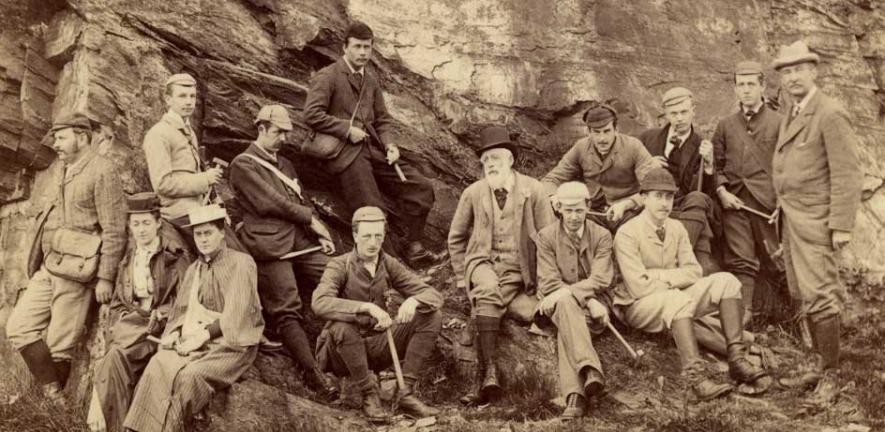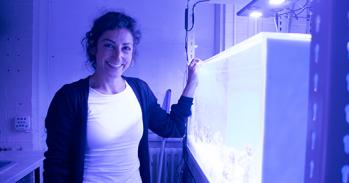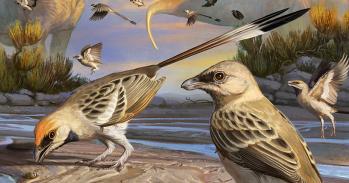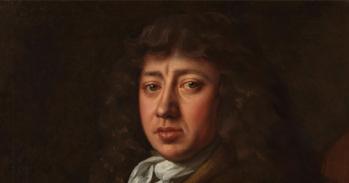
A display of material from the Sedgwick Museum records archive, on view to the public from tomorrow, offers a rare glimpse into the daily lives of the scientists who changed the way we think about the world around us.
A display of material from the Sedgwick Museum records archive, on view to the public from tomorrow, offers a rare glimpse into the daily lives of the scientists who changed the way we think about the world around us.
The best analogy of how an archivist approaches an archive is that of investigators arriving at a crime scene – you have to be really careful not to destroy any of the tiny clues within it.
Sandra Marsh
“The Queen Hotel (6/- per day – hot baths extra) was extremely comfortable, while a wide garden provided space for lounging and for cricket (week-days only).” So wrote Gertrude Elles (1872-1960), a geologist known for her work on graptolites, in 1914 describing a field trip to Dolywern in Wales with a group of Sedgwick Club members. She continued: “N.B. Future visitors should note that the establishment does not approve of sabbatical games; even the sheep do not talk before lunch time on Sunday, & our hammers alone broke the universal peace.”
The fragile leather-bound book containing Elles’s account of an excursion in an era when life in Wales was regulated by stern Methodism, and Britain was on the brink of the First World War, is just one of many thousands of items held in the archive of the Sedgwick Museum of Earth Sciences.
Today the Sedgwick Museum launches a display that gives visitors a glimpse into its extraordinary collections of records, made by generations of students and researchers, and given to the Museum (and the collections that preceded it) over a 300-year period. They include some of the best-known names in the field of Earth sciences, among them geologist Adam Sedgwick (1785-1873), petrologist Alfred Harker (1859-1939), and explorer Sir Vivian Fuchs (1908-1999).
The display, which is open to the public from tomorrow onwards, showcases a small selection of items from the archive’s collections, chosen as much to tell the human story of Earth sciences as the scientific story of the discovery of the secrets of the Earth – from initial sketches of fossils in the 17th century to the diaries of those exploring Greenland and its landscape in the 21st.
The records held by the Sedgwick Museum archive are striking in their diversity. They range from notebooks stuffed with sketches and albums of faded black-and-white photographs to letters and diaries rich with anecdotes. Among the oldest and most precious items are original copies of Dr John Woodward’s An Attempt towards a Natural History of the Fossils of England, dating from 1728-29, and the Italian painter and palaeontologist Agostino Scilla’s original fossil sketches, also dating from the 17th century. One of the largest objects is an imposing portrait in oils of geologist John Marr (1857-1933). The smallest include notebooks belonging to Adam Sedgwick.
The archive itself is housed in the Archive Room at the Brighton Building, home of the Department of Earth Sciences’ Geological Conservation Laboratory. The building is named in honour of Albert (Bertie) Brighton (1900-1988), who was the Sedgwick Museum’s first professional curator. The meticulous card-index system that Brighton compiled, still contained in its original wooden filing system, and his subsequent typed entries stored in large red folders, represent an important part of the archive.
The display celebrates the completion of the first stage of what is hoped will be a long-term project to catalogue all the material given to, and acquired by, the Museum. In 2010 the Sedgwick Museum was enabled by a grant from Museums, Libraries and Archives Council to appoint its first-ever archivist to undertake the preliminary work of arranging items stored in more than 900 cardboard boxes into a number of distinct collections and identifying where conservation was urgently required.
When archivist Sandra Marsh arrived to take up her post, which initially had funding for just a year, later extended with support from the Isaac Newton Trust, she faced a formidable challenge. With the help of a part-time assistant, Dr Lyall Anderson, and a small team of volunteers, her chief task was to get a picture of what the archive contained without disturbing the elements of order that might lie within it.
“The best analogy of how an archivist approaches an archive is that of investigators arriving at a crime scene – you have to be really careful not to destroy any of the tiny clues within it. It’s a question of stepping back and trying to get an overall picture of how the person or organisation kept their records and why,” said Marsh.
“Some of the collections that we identified had been carefully numbered by their creator such as the notebooks of Alfred Harker– others were simply loose items put in boxes and given to curators of the Museum. Some were incredibly fragile such as the Sedgwick Club scrapbooks. And all are unique in terms of what they contribute to the story of the development of Earth sciences as a discipline and what they tell us about the environment in which past scientists worked. In the 1880s, for example, the railways were still a novelty and geologists walked huge distances to look at sites.”
Over the last 18 months Marsh and her team have sub-divided the main archive into 30 distinct archive collections. This entailed carefully transferring letters, drawings, notebooks and other material from the battered cardboard boxes that held them into conservation grade archive boxes and arranging them on metal shelving. The introduction of a cataloguing system covering these collections means that they can now begin to be accessed by researchers quickly and with a minimum of handling.
One of the most delightful of the individual archive collections is that of the Sedgwick Club, which was founded in 1880 with membership initially restricted to ten men. The Sedgwick Club remains a flourishing Cambridge University society today and its members pose for an annual photograph with the club’s metal box standing in the foreground.
“It’s fascinating to read the accounts of geological excursions in the 1880s, look at the photographs of men and women looking for fossils, the limericks they wrote and sketches drawn of one another. Many of the scrapbooks are extremely fragile and need treatment before being made accessible. Funding for this, and to undertake the vital job of cataloguing the rest of the archive, is urgently needed – and there are still lots of fascinating stories left to uncover,” said Marsh.
Although much remains to be done, this huge task has got off to a good start. At the Brighton Building, a plaster bust of Adam Sedgwick (the original can be found in Trinity College) now overlooks the newly-organised Archive Room. His benign and craggy face is a reminder of the determination of early geologists whose papers are now stored in conservation boxes, secure for future generations.
This work is licensed under a Creative Commons Licence. If you use this content on your site please link back to this page.





